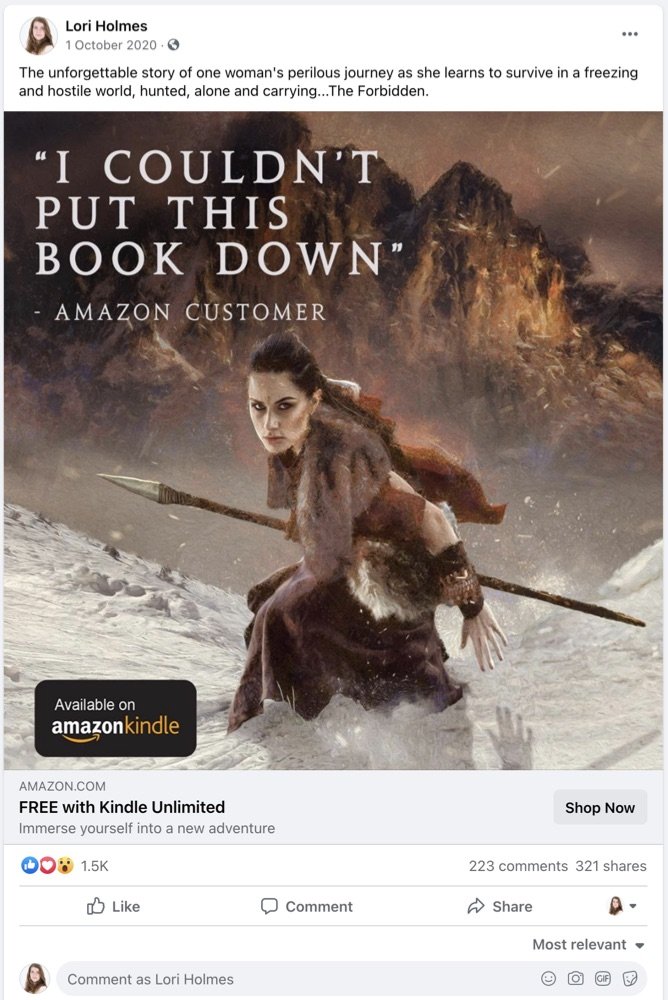Here’s another great post from Jane Friedman’s blog, and I’ll pause right here to urge you to check out her website. It has tons of great information and I could bounce around reading blog posts all day and never run out of things to learn. Of course everything isn’t interesting to everybody, but there’s something there for everybody who writes, in one way or another. Of special note is her free email newsletter, which may or may not come with a new fascinating tidbit that’s pertinent to you every time, but hey…it’s email so it’s easy to check out and delete if it’s not up your alley.
This post is by book advertising consultant Matt Holmes, and it’s one of the most detailed, thorough, and well-illustrated discussions on marketing how-to I’ve ever seen, particularly for something free to whoever wants to go looking for it. And you can never have too much free advice. There’s one very significant thing about advice: you never really know whether it’s any good until after you’ve taken it. So consider it carefully and remember that even when you get good advice, it’s not going to do much good until you put time and effort and money into it. It’s advice, not magic.
I’ve only tried running Facebook ads a couple of times, and was unimpressed with the results, but I was trying it on my own, on the fly, without a clue. Experimenting. The task is complex, complicated, and daunting to the uninitiated, but made much clearer, right here, by someone with experience and success.
Writing a book is quite a daunting undertaking, too, but when you get done with it, you have to get it out there to people who want to read it or its purpose is never truly fulfilled. You do that by marketing it, and for most of us — the ones who end up self-publishing — that responsibility falls upon our own shoulders. And we need all the help we can get.
Here you go!
How Authors Can Leverage Facebook Ads to Sell More Books
June 15, 2021 by Matt Holmes

Today’s post is by book advertising consultant Matt Holmes.
When authors want to advertise their books, three advertising platforms spring to mind for most: Facebook ads, Amazon ads, and BookBub ads.
And while each of these platforms can be amazing in their own right and even more so when used holistically together, without a strong foundation (i.e. a great book that has been edited and proofread, a strong book description, right pricing for your category or genre, a professional-looking book cover that fits in your genre, etc.), no amount of advertising can sell a poor quality book.
Once you have a strong foundation, the truthis that advertising takes time to perfect; it takes testing; it takes patience, persistence, and, ultimately, it takes money.
However, let’s brighten things up.
When you get your ads dialed in, they can truly transform your career.
As an example, my wife is an author of fantasy novels. Before we started advertising her debut series of books, we were lucky if they pulled in $40 per month!
Last month, this same series earned $8,550 in royalties, with $5,200 of profit—and that’s with just one series of three books; the fourth book is due out later this year.
And the advertising platform that did the brunt of the leg work was…
Facebook ads.
Let’s dive into it. Here’s what you’ll learn.
- Why Facebook offers authors an incredible opportunity to position themselves in front of their ideal readers
- When to use Facebook ads
- Are Facebook ads worth your time and money?
- How to create scroll-stopping Facebook ads
- My top 5 Facebook ads tips for authors
The Facebook ads opportunity
Facebook’s biggest and most valuable asset is data. As an advertiser on Facebook, you can tap into this data and pinpoint the exact people (readers) you want to reach with your ads.
As an example, if you know your readers:
- Live in New York
- Are female
- Aged between 45 and 55
- Work as an accountant
- Have been a newlywed for 6 months
- Recently moved
- Enjoy French cuisine
- Own a dog and a fish
- And do yoga
You could potentially target them! Now, I wouldn’t recommend being this granular with your targeting; this is just an exaggerated example to show you how much Facebook knows about its user base. In fact, I have seen better results by leaving my targeting fairly open. I trust Facebook enough to go out and find the right people to position the books I’m advertising in front of.
So what sort of targeting should you be doing with your Facebook ads?
Targeting is a big topic and what works for one author won’t necessarily work for another. However, myself and many other authors have seen the best results by targeting:
- Author names
- Book / series titles
- TV shows
- Movies
- Genres (e.g., romantic fantasy)
As long as your targeting is relevant to the book you’re advertising, it’s worth testing. That’s not to say that every target you test will be a winner, but the more relevant you can be, the higher the chance of your Facebook ads converting into sales and therefore providing you with a positive Return on Ad Spend (ROAS); in other words, profit.
When researching potential targets, I can’t recommend enough that you keep track of all your tests in a spreadsheet. I have built my own Targeting and Tracking spreadsheet which you can use for free; it’s included in my Author Ads Toolkit, which comes with several other valuable resources.
It’s also worth noting that Facebook ads allow you to advertise not just on the Facebook News Feed, although that is where you are likely to see the majority of your traffic coming from, but also on Facebook Stories, Instagram Stories, Instagram Feed, Facebook Messenger and many more.
Before we move on, let’s first take a quick look at what a Facebook ad actually looks like.

This is one of the ads I’ve run for my wife’s series of fantasy novels.
If you’ve spent any length of time scrolling on your Facebook News Feed, I’m sure you recognize the layout and style of this ad. As you can see, Facebook wants their ads to fit in with an organic post (i.e., not an ad) that you might see from one of your Facebook friends.
I’ll be walking you through the different assets that make up a Facebook ad, as well as some tips and best practices on how to create scroll-stopping ads.
